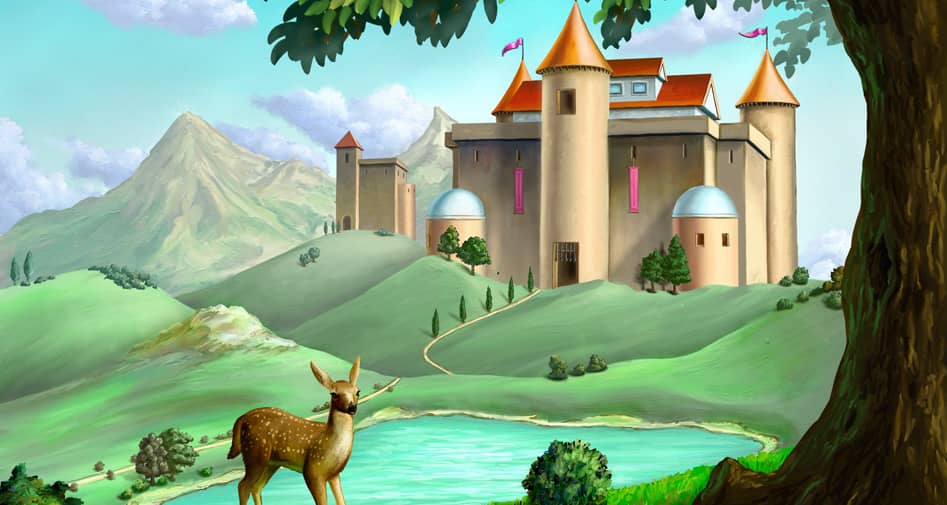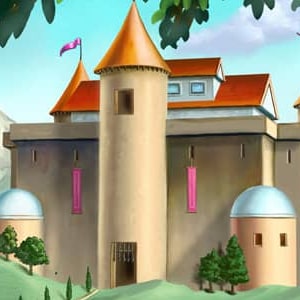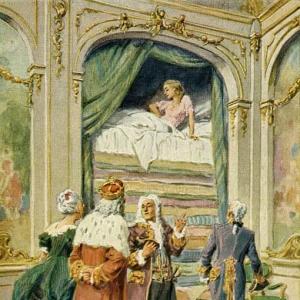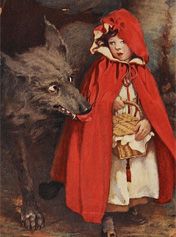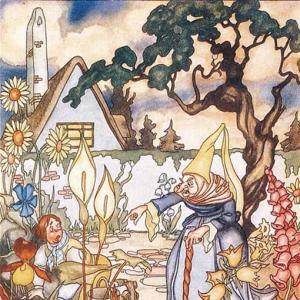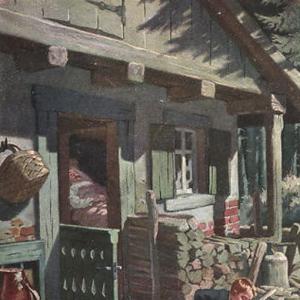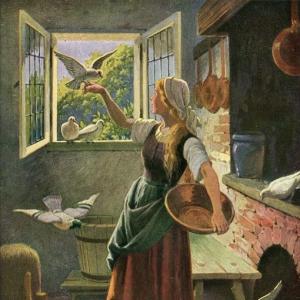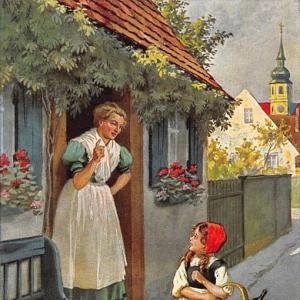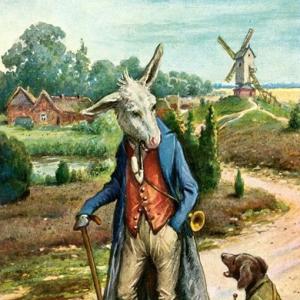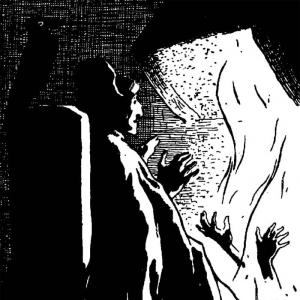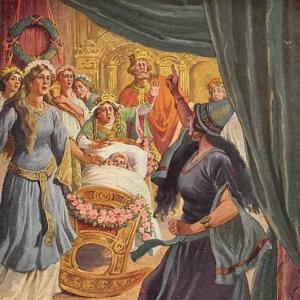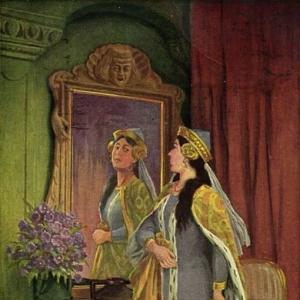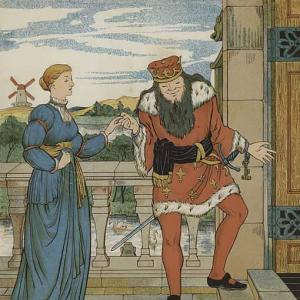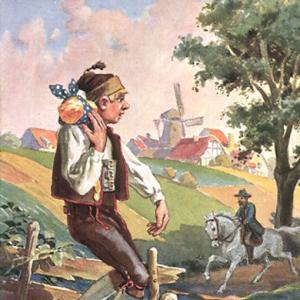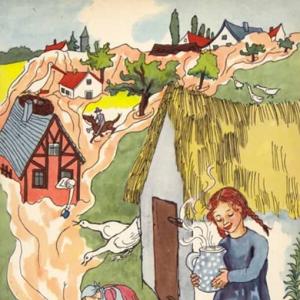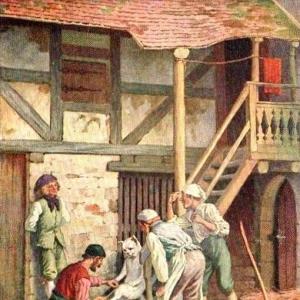Reading time for children: 4 min
There was once upon a time a young peasant named Hans, whose uncle wanted to find him a rich wife. He therefore seated Hans behind the stove, and had it made very hot. Then he fetched a pot of milk and plenty of white bread, gave him a bright newly-coined farthing in his hand, and said, „Hans, hold that farthing fast, crumble the white bread into the milk, and stay where you are, and do not stir from that spot till I come back.“ – „Yes,“ said Hans, „I will do all that.“ Then the wooer put on a pair of old patched trousers, went to a rich peasant’s daughter in the next village, and said, „Won’t you marry my nephew Hans — you will get an honest and sensible man who will suit you?“ The covetous father asked, „How is it with regard to his means? Has he bread to break?“ – „Dear friend,“ replied the wooer, „my young nephew has a snug berth, a nice bit of money in hand, and plenty of bread to break, besides he has quite as many patches as I have,“ (and as he spoke, he slapped the patches on his trousers, but in that district small pieces of land were called patches also.) „If you will give yourself the trouble to go home with me, you shall see at once that all is as I have said.“ Then the miser did not want to lose this good opportunity, and said, „If that is the case, I have nothing further to say against the marriage.“
So the wedding was celebrated on the appointed day, and when the young wife went out of doors to see the bridegroom’s property, Hans took off his Sunday coat and put on his patched smock-frock and said, „I might spoil my good coat.“ Then together they went out and wherever a boundary line came in sight, or fields and meadows were divided from each other, Hans pointed with his finger and then slapped either a large or a small patch on his smock-frock, and said, „That patch is mine, and that too, my dearest, just look at it,“ meaning thereby that his wife should not stare at the broad land, but look at his garment, which was his own.
„Were you indeed at the wedding?“ – „Yes, indeed I was there, and in full dress. My head-dress was of snow. Then the sun came out, and it was melted. My coat was of cobwebs, and I had to pass by some thorns which tore it off me, my shoes were of glass, and I pushed against a stone and they said, „Klink,“ and broke in two.
 Learn languages. Double-tap on a word.Learn languages in context with Childstories.org and Deepl.com.
Learn languages. Double-tap on a word.Learn languages in context with Childstories.org and Deepl.com.Backgrounds
Interpretations
Adaptions
Summary
Linguistics
„Hans Married“ is a lesser-known fairy tale by the Brothers Grimm, Jacob (1785-1863) and Wilhelm Grimm (1786-1859). They were German academics, linguists, cultural researchers, and authors who collected and published folklore during the 19th century. Their collection of fairy tales, known as „Grimm’s Fairy Tales“ or „Children’s and Household Tales“ (originally „Kinder- und Hausmärchen“), includes some of the most famous stories known today, such as „Cinderella,“ „Hansel and Gretel,“ „Rapunzel,“ and „Snow White.“
The Brothers Grimm aimed to preserve the cultural and folkloric heritage of Germany and other European countries. They collected their stories from various sources, including oral traditions, manuscripts, and printed books. Some stories were shared with them by friends, acquaintances, and even strangers. Over the years, they revised and expanded their collection, which ultimately grew to over 200 tales.
„Hans Married“ is one of the less popular and studied stories within the Grimm Brothers‘ collection. Like many other Grimm tales, it explores themes such as deception, greed, and the consequences of placing too much importance on material wealth. These themes, as well as the use of satire and absurdity, are characteristic of the Brothers Grimm’s storytelling and reflective of the societal values and norms of the time.
There are several interpretations one could draw from the fairy tale „Hans Married“ by the Brothers Grimm:
Deception and Miscommunication: The story showcases the consequences of deception and miscommunication, as Hans‘ uncle uses clever wordplay to make the girl’s father believe that Hans is wealthy. Hans, unaware of his uncle’s deceit, plays along with the ruse unwittingly. The tale serves as a cautionary message about the importance of honest communication and understanding in relationships.
Greed and Materialism: The girl’s father is portrayed as a greedy and materialistic individual who readily agrees to the marriage after believing that Hans has a considerable amount of land and wealth. This theme highlights the negative aspects of valuing material possessions over personal qualities, such as love and character.
Illusion versus Reality: The story plays with the idea of illusion versus reality, as Hans‘ uncle manipulates the girl’s father into believing that Hans is wealthier than he truly is. The concept of patches on clothing, mistaken for land patches, serves as a metaphor for the misconceptions that arise when people prioritize appearances over truth.
Satire and Absurdity: The Brothers Grimm often used satire and absurdity in their fairy tales to make a point or highlight societal issues. In this story, the absurd situations and descriptions, such as the wedding guest’s peculiar outfit, serve to emphasize the ridiculousness of the events and the characters‘ actions.
Overall, „Hans Married“ explores themes of deception, greed, illusion, and satire, offering a critical look at the consequences of dishonesty and materialism in relationships and society.
The fairy tale „Hans Married“ has been adapted and reimagined in various forms over the years. Here are a few notable adaptations:
„Hans in Luck“ (1955) – This is a short film directed by Lotte Reiniger, a pioneering animator who used cut-out silhouettes to create her films. The film follows the basic storyline of the original tale, with Hans trading his gold for a series of animals and ultimately ending up with a grindstone.
„The Lucky One“ (1991) – This is a children’s book by Ursula Dubosarsky that takes inspiration from „Hans Married“ but reimagines the story with a modern twist. The protagonist, a boy named Harry, finds a lucky stone and believes it will bring him good fortune. However, his obsession with the stone causes him to overlook the people and experiences that truly make him happy.
„The Wonderful Adventures of Nils“ (1906) – This is a Swedish children’s book by Selma Lagerlöf that features a character named Nils who embarks on a journey through Sweden with a group of wild geese. The book has been compared to „Hans Married“ for its emphasis on simplicity and nature.
„Happy Hans“ (1999) – This is a play by Philip Osment that reimagines the story of Hans as a gay man living in London. The play explores themes of identity, relationships, and the search for happiness, while still retaining the basic storyline of the original tale.
„Hansel & Gretel: Witch Hunters“ (2013) – This is a Hollywood action-horror movie that takes inspiration from various fairy tales, including „Hans Married.“ In the movie, the characters Hansel and Gretel are grown-up versions of the siblings from the classic fairy tale and work as bounty hunters tracking down and killing witches. While the film has little in common with the original story of „Hans Married,“ it’s an example of how fairy tales can continue to inspire new works of art and storytelling.
Once upon a time, there was a young peasant named Hans, who was urged by his uncle to marry a rich wife. To prepare Hans for the meeting, his uncle placed him behind a hot stove with milk, bread, and a farthing coin, instructing him not to move until he returned. The uncle, dressed in patched trousers, went to a nearby village and proposed a marriage between his nephew and a wealthy peasant’s daughter. To prove Hans‘ worth, he convinced the girl’s father that Hans had plenty of money and land, referring to his patches as land.
The father agreed to the marriage, and the wedding took place. After the wedding, Hans showed his wife the „property“ he owned by pointing to the patches on his smock-frock whenever they saw a boundary line or land division, trying to make her believe that he owned the land. The story concludes with an attendee at the wedding describing their own peculiar outfit, highlighting the absurdity of the situation.
The excerpt from the Brothers Grimm fairy tale „Hans married“ presents a humorous and satirical narrative with elements of deception, materialism, and cultural nuances.
Hans: is a simple, obedient peasant who follows his uncle’s instructions without question, indicating a passive and naive personality.
The Uncle/Wooer: uses clever wordplay and persuasive language to paint an exaggerated picture of Hans’s wealth. His speech is characterized by euphemism and implication, as seen in the line about having „quite as many patches. “ The use of the ambiguous term „patches“ serves as a pun to imply both poverty (patched clothing) and wealth (land ownership).
Symbolism and Metaphors
Patches and Clothing: The patches on Hans’s clothing symbolize poverty, while being metaphorically adapted to signify land ownership and wealth. This duality underscores the theme of deception.
Boundary Lines and Fields: These serve as metaphors for property and wealth, with Hans humorously claiming them by pointing to the patches on his clothing rather than actual land, emphasizing the farcical nature of the tale.
Materials of Attire: The description of the wedding visitor’s attire (snow, cobwebs, glass) reflects a surreal, fantastical element typical of fairy tales, adding to the story’s whimsy and imagination.
Themes and Motifs
Deception and Gullibility: The uncle’s manipulation of language and visual cues (patches) to deceive the prospective in-laws highlights themes of deception and gullibility.
Materialism and Social Status: The story critiques social norms, focusing on the importance assigned to wealth and appearances in marital arrangements.
Cultural and Societal Commentary: The tale humorously critiques societal values around marriage, wealth, and appearances. The uncle’s crafty use of words and Hans’s passive acceptance of his role reflect a satire of how material wealth often outweighs individual merit in societal judgments.
Narrative and Structure: The tale is structured with a straightforward but ironic narrative, typical of Grimm fairy tales. It moves quickly from problem (finding a wife) to resolution (marriage), using vivid imagery and dialogue to drive the plot. The ending, featuring the surreal wedding guest, adds an unexpected twist, typical of the Brothers Grimm’s narrative style to invoke a sense of magic and unpredictability.
In summary, the linguistic elements of this fairy tale highlight the themes of materialism, deception, and the absurdity of social conventions, all delivered with the humor and whimsy characteristic of the Brothers Grimm’s storytelling.
Information for scientific analysis
Fairy tale statistics | Value |
|---|---|
| Number | KHM 84 |
| Aarne-Thompson-Uther-Index | ATU Typs 859B |
| Translations | DE, EN, DA, ES, PT, IT, JA, NL, PL, RU, TR, VI, ZH |
| Readability Index by Björnsson | 37.1 |
| Flesch-Reading-Ease Index | 77.5 |
| Flesch–Kincaid Grade-Level | 9 |
| Gunning Fog Index | 11.8 |
| Coleman–Liau Index | 7.2 |
| SMOG Index | 8.4 |
| Automated Readability Index | 10.1 |
| Character Count | 2.310 |
| Letter Count | 1.747 |
| Sentence Count | 17 |
| Word Count | 448 |
| Average Words per Sentence | 26,35 |
| Words with more than 6 letters | 48 |
| Percentage of long words | 10.7% |
| Number of Syllables | 543 |
| Average Syllables per Word | 1,21 |
| Words with three Syllables | 14 |
| Percentage Words with three Syllables | 3.1% |
